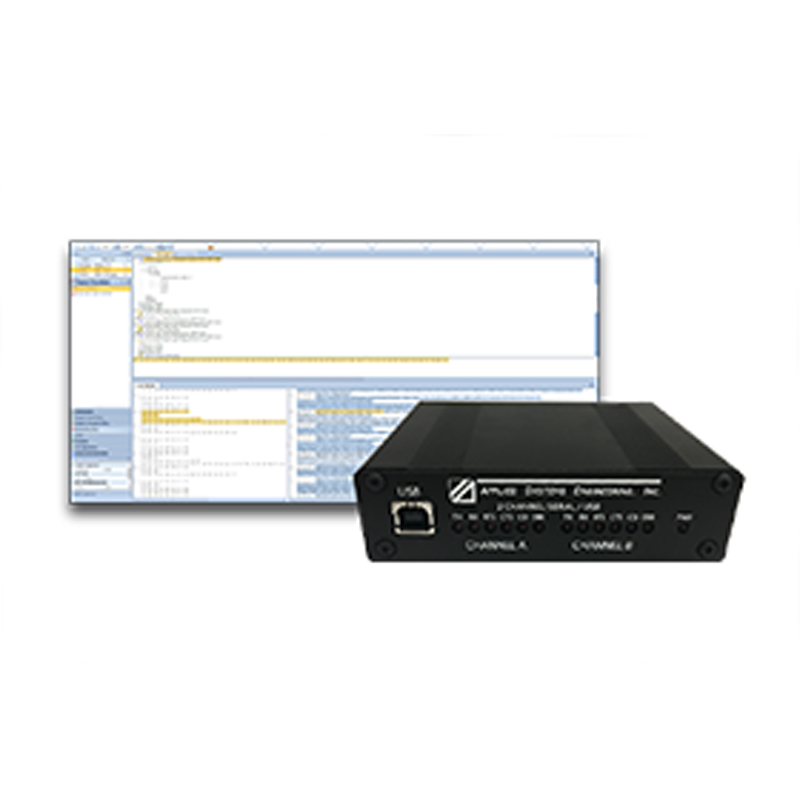
ASE2000 Version 2 RTU Test Set
Part No.: MPKK-ASE2000-Version-2-RTU-Test-Set
It supported by ASE2000 which runs on 32-bit and 64-bit Windows 7, 8, 10, XP, Vista.
Product Description
ASE2000 Version 2 RTU Test Set
ASE protocol and communication test products, are used worldwide by RTU and IED equipment manufacturers, electric power utilities, and SCADA system vendors. Over 75 protocols are supported by ASE2000 which runs on 32-bit and 64-bit Windows 7, 8, 10, XP (SP2, SP3), Vista.Overview
On August 31, 2011 ASE introduced Version 2 of its popular ASE2000 Communication Test Set (Version 1). In addition to all features in the prior version, ASE2000 Version 2 adds:- Task Mode for easy operation of protocol-specific tasks such as data acquisition and control, without the need to edit communication message exchanges
- Support for DNP3 certification procedures, levels 1 and 2
- Support for DNP3 secure authentication
- Support for File Transfer
- Expanded Messages View for detailed identification of communication message contents
Current technology protocols included as standard on all units:
- DNP3 serial
- DNP3 LAN/WAN
- IEC 60870-5-101
- IEC 60870-5-104
- Modbus serial (RTU and ASCII)
- Modbus network (TCP)
- CDC Types I and II
- Conitel (most variations)
- Harris 5000/6000
- Telegyr 8979
All protocols are supported in a single program with a single user interface. The ASE2000 provides a total solution approach to the area of protocol test equipment software and its family of PC based protocol test equipment that includes USB serial communication hardware and Bell-202 modems.
ASE2000 Version 1 was first introduced in 1999 (replacing older Comm/32 and Comm/64 models) and has a current installed base of several thousand units in numerous utilities and SCADA industry companies worldwide.
.jpg)
ASE2000 Version 2, introduced in September, 2011, expands on Version 1 features by supporting operation in Exchange and Task modes. Exchange mode implements Version 1 features and operation. Task mode, new in Version 2, adds a simplified means to performing a set of common tasks such as device initialization, data acquisition, controls, and file transfers. Task Mode operation requires only that the user select a RTU/IED device and a task to be performed. Communication message editing, frequently required in Version 1, is automated in Version 2.
ASE2000 Version 2
The ASE2000 RTU Test Set is a full-featured protocol test unit that provides the user with a powerful and flexible tool for testing and maintaining SCADA RTU and SCADA IED equipment and diagnosing communication problems.
User Interface
ASE2000 operation is a menu driven, window oriented interface, developed in line with standard Windows interface presentation guidelines. Set-up screens allow the user to define test session specific information and user preference information. For quick-start operation, the supplied default values for most test operations are sufficient and preclude the need for lengthy and complicated pre-test set-up. For tests that do require special conditions, a set of intuitive and easy to use set-up screens is provided. Special set-up conditions can be saved to uniquely named files and easily retrieved for use in future sessions. Many users develop a library of frequently used test scenarios with this feature thereby eliminating repetitive set-up for future test sessions.
Display Options
Display screens provide dynamic data display during monitoring and simulation mode test sessions.
- Users are not limited to a single display format for message data. In addition, message data can be displayed in Interpretive Mode which identifies, in English, the various message elements and their values, Raw Data Mode which displays only the numeric message data, or both. Point data is available for presentation in tabular format.
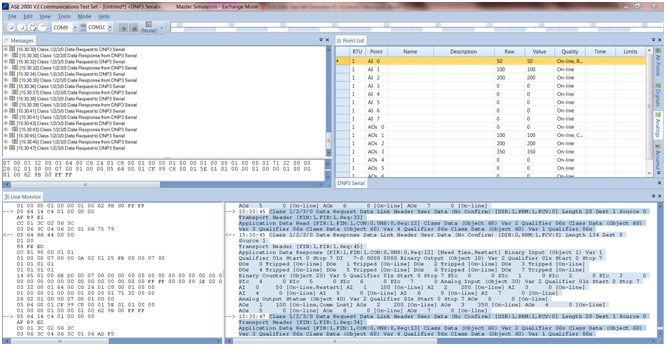
The Line Monitoring view in Versions 1 and 2 shows communication line data in raw and interpretive styles. Clicking on a field or value in one side highlights the corresponding field in other side
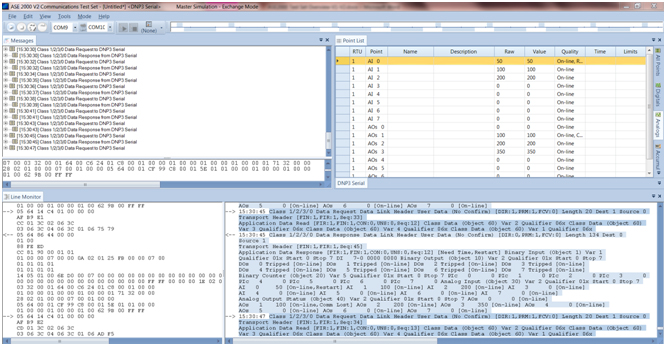
The Messages View in Version 2 presents communication line data in an alternate format with “zoom-in” details
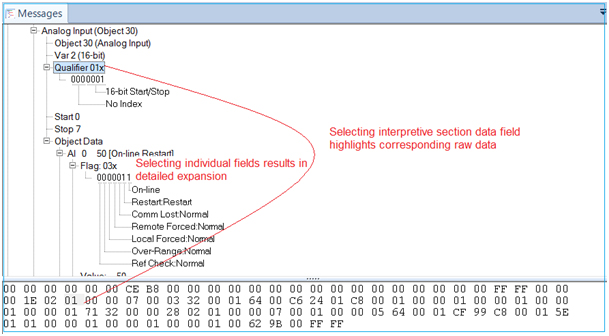
The Point Values View in Versions 1 and 2 shows point names, values (raw and scaled), quality codes, and times

Modes of Operation (Version 1 and Version 2/Exchange Mode)
The ASE2000 test set has three modes of operation, Master Simulation (communicating to a downstream device or RTU), RTU Simulation (communicating to a master station), and Line Monitor (listening to communications between Master and RTU/IED devices).
Master Simulation Mode provides the capability to issue data scan requests and supervisory control commands to one or more RTU's on a communication line. The set-up screens for this mode allow the user to define a test scenario that identifies which device(s) to communicate with, which commands to issue for each device, frequency of commands, screen format and display format of message data.
RTU Simulation Mode allows the user to configure the ASE2000 RTU test set as one or more RTU's to respond to data scan requests and supervisory control commands. Convenient set-up menus allow the user to specify point types, number of points, and point ordering that will result in the proper data message structure. Point modeling can also be enabled to provide data value changes on successive data scans.
Line Monitoring Mode is used to monitor communication between a master station and all RTU/IED devices on a communication line. Message data for both directions is shown.
Modes of Operation, Version 2 Task Mode Enhancements
ASE2000 Version 2 adds Task Mode. In this mode, the ASE2000 operates from a user defined RTU/IED device data base. Each definition includes counts and address of all input points at that device.

Task Mode/Master Simulation provides the user with a set of tasks applicable to the protocol of the selected device. Activating a task causes appropriate messages to be built and transmitted to accomplish the selected task for the device's protocol and point configuration.
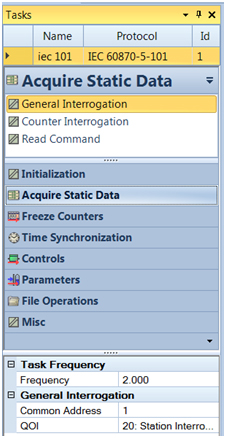
Task Mode/RTU Simulation allows individual points states/values to be entered from the Point Values view. New values are transmitted in the next applicable scan response, with time stamps if appropriate to the protocol. In addition, the user can define point modeling parameters to automatically generate point changes.
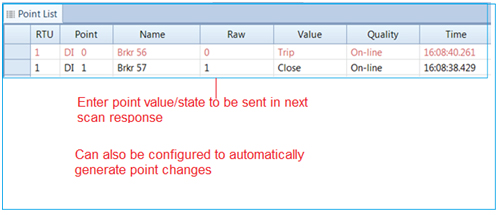
Advanced Features
A number of advanced features are available for specialized test requirements.
Event Logging generates a text file recording significant events including:
- High/low limit alarms for selected analog input points
- State changes for selected digital input points
- Communication errors
- Detection of specific communication messages, such as trip/close commands
- Online communication can be triggered to stop when a selected event is detected, thereby creating a record of communication activity prior to the event
Signal Analysis is available to users with an ASE supplied communication device (BCOM-USB) and provides a plot of bidirectional carrier and data signals to 0.1 millisecond resolution.
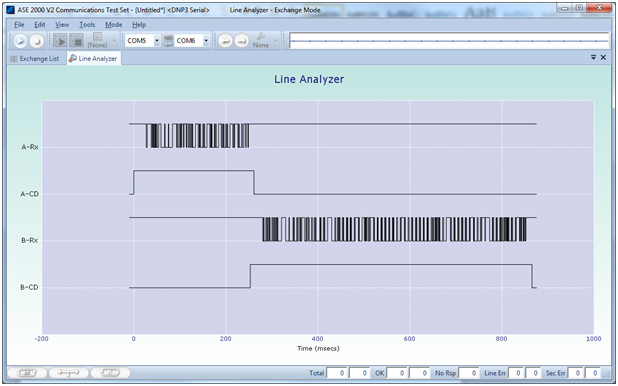
DNP3 Certification testing support files are included with the ASE2000 Version 2 software at no additional charge. An automated test results report can be generated through standard browser.
Transport Certification Test Results
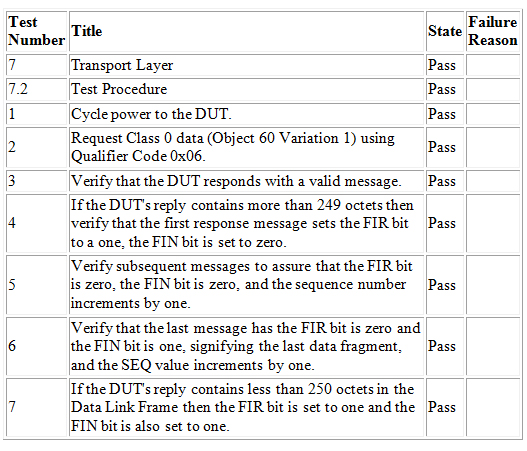
Configuration Options
The ASE2000 RTU Test Set is available in various models that differ only by communication hardware; the software is identical. The ASE2000-COM supports Asynchronous Byte and Network protocols only. Standard PC COM ports cannot support bit-oriented communication used by many of the older legacy protocols. The ASE200-USB-RS and ASE2000-USB-M, which utilize ASE's dual-channel BCOM-USB device (pictured below), support all protocols.
ASE2000-USB-RS
The ASE2000-USB-RS supports all asynchronous serial, synchronous serial, and network protocols. Serial communication is supported through ASE's BCOM-USB, a USB Bus powered, two-channel, serial RS-232 communication device. The two RS-232 ports support both synchronous (bit protocol) and asynchronous (byte protocol) communication. A set of RS-232 LED's for each channel show TX, RX, RTS, CTS, and CD status. Connection to the PC is via a standard USB device cable. Both USB 2.0 and USB 1.1 standards are supported. RS-232 communication operates from 50 to 56K baud for byte-oriented protocols, and from 50 to 2400 baud for bit-oriented protocols.
Network protocol communication uses standard PC network hardware. For network protocols, the BCOM-USB device provides the license. That is, the ASE software will not operate without the BCOM-USB device inserted although it is not actively involved in network communication.
An upgrade path to the BCOM-USB device is available to users of ASE's older PCMCIA card, or for upgrade from an ASE2000–COM model. Upgrade requires return of the current hardware (PCMCIA card or dongle) within six weeks after delivery of the BCOM-USB device.
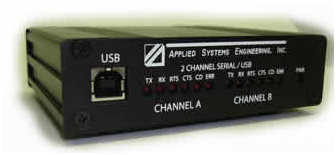
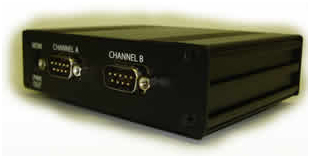
ASE2000-USB-M
Model ASE2000-USB-M includes all hardware provided in the ASE2000-USB-RS, plus a dual-channel Bell-202 modem. The modem is powered from the BCOM-USB device. The same software is provided for model ASE2000-USB-M as for model ASE2000-USB-RS.
ASE2000-COM
The ASE2000-COM utilizes standard PC COM ports and is suitable for users that require support for asynchronous byte oriented and network protocols only, all using standard PC hardware or USB to serial devices manufactured by others.
The ASE2000-COM model:
- Supports only asynchronous byte and network protocols. This includes protocols such as DNP3, IEC 870-5, and Modbus
- Does not support ASE's dual-channel Bell-202 modem since that modem derives its power from the BCOM-USB device. The COM model will operate with an external modem. ASE sells single-channel external Bell-202 and V.23 modems
- Does not support the Line Analyzer function
- Does not support modem timing properties (pre-transmission mark, post-transmission mark, and receiver squelch times)
- All ASE2000 models require two COM ports to support serial protocol Monitor Mode operation. Users who wish to operate in Monitor mode should verify that their computer is equipped with two serial ports. (ASE's BCOM-USB device does contain two serial ports.
Key Features
General
- Graphics window / menu screen presentation with keyboard or pointer navigation
- Common user interface set-up displays, independent of protocol
- Custom display of data with protocol specific formatting
- User preference set-up and save
- Extensive On-Line help facility
- Supports 32-bit and 64-bit Windows systems
Line Monitoring
- Real-time, time stamped display of message data
- Interpreted and raw data display
- Display filtering options
- Event triggering
- Disk storage / retrieval of message data from test sessions. Files can be sent to anyone for use with a free viewer available to non-ASE2000 users
- Communication statistics (message count, parity errors, security errors, etc.)
Master Simulation
- Data and control requests to one or more devices
- ASE2000 defined test scenarios
- User defined test scenarios
RTU Simulation
- User configurable to respond to master requests for multiple devices (party line)
- Point value modeling for data change activity (analog, digital, accumulator)
Advanced Features
- User configurable event log for communication errors, analog limit exceptions, digital point changes, selected message types (supervisory control)
- Event triggering
- RTU response time measurement (1 msec. resolution using ASE's BCOM-USB device)
- Low level control over message structure, security error, message timing, and other fields to allow customization for advanced testing requirements
- Communication error generator for error detection testing
DNP3 Extras
- Certification testing scripts
- Secure authentication support
- Automated file transfer procedures
SCADA or RTU
Over the years various names have been given to a box which essentially performs the following functions: Test the Remote Terminal Unit (RTU) communication and point I/O; Test the Master station communication and point I/O; Test the communications circuits between the Master and RTU units; advanced testers capable of analyzing the communications data stream from Master to RTU; capable of converting raw hexadecimal values into Readable characters for human users; even more advanced features for data acquisition and control capabilities and automated testing. The ASE2000 can perform all of these functions.
SCADA Test Set: Most original RTU manufacturers who developed proprietary protocols to speak from their master station to their RTU, also created a testing box. This Box became known as a RTU Tester, RTU Test Set, and sometimes I/O Test set. These large heavy duty test sets could withstand a lot of abuse. Conitel 2020, Harris 5000/6000, CDC Type 1, Tejas 3 and Tejas 5, BBCSI, are a few of the manufacturers' boxed test set we have worked with in the past. They are still in the field and are very reliable, however they weighed 50 pounds and could only emulate one protocol.
Protocol Analyzer: With the advent of Personal computers, and a few clever software developers, a second generation of 'Test sets' arose. They first appeared on “Lunch box” or “luggable” portable computers (Although movable, they were not particularly light, and were definitely not for your lap!). This generation of protocol analyzer was based on DOS operating system, and had no mouse support. Function keys ran everything. (only F1 through F8). However the bits and bytes could now be analyzed and displayed in ASCII or Text for a human to read. This version of the Protocol Analyzer grew in functionality as did the personal computer. Today we have the full featured Windows XP Pro/Vista version, which has all of the capabilities listed above.
Protocol Translator: Although North Americans have called capabilities listed above, one of the following: RTU Test Set, IED Test Set, SCADA Test Set, RTU Protocol Analyzer, IED Protocol Analyzer, or SCADA Protocol Analyzer; the international community has requested a 'Protocol Translator' (translate a protocol to English) test set. In North America we normally consider a protocol translator to be a device (like the SPT4-NET) which converts one protocol to another protocol (DNP 3 to IEC 870-5-101).
If you have some fond memories of systems from the past, please use our contact us form, and we will try to post relevant informative information in regards to legacy test test units.